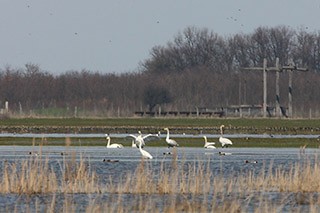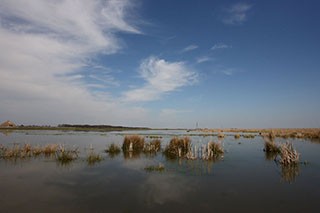
News
We are pleased to announce that on the occasion of Earth Day, April 22, Minister for Agriculture Dr. István Nagy has granted the Pro Natura Award to the Hortobágy Nature Conservation Association.We would like to thank the Hortobágy National Park Directorate and Gergely Árpád Medgyesi, Director of HNPI for the nomination.
The Hortobág
y Nature Conservation Association was exactly 30 years old when the award was presented. It was founded in June 1993 in Balmazújváros, with the aim of promoting practical conservation work in the area of the Hortobágy National Park Directorate in cooperation with the Hortobágy National Park Directorate in the field of nature and bird protection in the almost 200,000-hectare Hortobágy small landscape. The conservation and survey data of all Hortobágy bird species have been published in a reference book (Ecsedi Z. ed. (2004). Hortobágy Nature Conservation Association - Winter Fair, Balmazújváros - Szeged. 598 pp.). With the support of an active membership of 200 people, they have been actively involved in four wetland conservation LIFE programmes, restoring the natural water flow of the bush on nearly 10 000 hectares and revitalizing the sodic pans and pasture ponds of the Solonyec. The experience gained was used to publish two books on the concept of conservation, restoration and adaptive management of the Carpathian Basin sodic lakes and the Hortobágy small landscape. Many efforts have been made to bring together conservationists, water managers, farmers and municipalities to take steps to implement conservation plans for sodic wetlands. Elements of sodic wetland rehabilitation and management have been fully developed to assist professional work.
|
Year |
2002 |
2003 |
2004 |
2005 |
2006 |
2007 |
2008 |
2009 |
2010 |
2011 |
2012 |
|
Species |
|
|
|
|
|
|
|
|
|
|
|
|
Podiceps nigricollis |
0 |
0 |
7 |
11 |
0 |
0 |
0 |
0 |
7 |
|
|
|
Podiceps grisegena |
0 |
0 |
0 |
0 |
0 |
0 |
3 |
0 |
3 |
|
|
|
Tachybaptus ruficollis |
0 |
0 |
6 |
9 |
0 |
22 |
26 |
0 |
40 |
|
|
|
Botaurus stellaris |
0 |
0 |
2 |
6 |
4 |
5 |
5 |
4 |
2 |
|
|
|
Ixobrychus minutus |
0 |
0 |
0 |
1 |
1 |
2 |
1 |
1 |
1 |
|
|
|
Anser anser |
0 |
0 |
0 |
2 |
6 |
5 |
9 |
7 |
16 |
|
|
|
Anas plat |
1 |
2 |
15 |
14 |
5 |
17 |
12 |
6 |
15 |
|
|
|
Anas acuta |
0 |
0 |
1 |
0 |
0 |
0 |
0 |
0 |
0 |
|
|
|
Anas querquedula |
0 |
0 |
14 |
21 |
12 |
19 |
15 |
12 |
17 |
|
|
|
Anas clypeata |
0 |
0 |
3 |
4 |
0 |
1 |
0 |
0 |
0 |
|
|
|
Anas crecca |
0 |
0 |
0 |
0 |
0 |
0 |
0 |
0 |
1 |
|
|
|
Aythya ferina |
0 |
0 |
0 |
7 |
0 |
2 |
6 |
2 |
14 |
|
|
|
Aythya nyroca |
0 |
0 |
4 |
10 |
0 |
11 |
10 |
0 |
11 |
|
|
|
Rallus aquaticus |
0 |
1 |
0 |
12 |
6 |
8 |
15 |
6 |
14 |
|
|
|
Porzana porzana |
0 |
0 |
5 |
7 |
1 |
3 |
1 |
0 |
2 |
|
|
|
Porzana parva |
0 |
0 |
0 |
2 |
1 |
1 |
7 |
2 |
4 |
|
|
|
Porzana pusilla |
0 |
0 |
0 |
? |
0 |
0 |
6 |
0 |
0 |
|
|
|
Gallinula chloropus |
0 |
0 |
2 |
2 |
2 |
3 |
12 |
3 |
5 |
|
|
|
Fulica atra |
0 |
0 |
15 |
18 |
0 |
16 |
28 |
2 |
45 |
|
|
|
Rec avosetta |
0 |
0 |
36 |
16 |
0 |
0 |
0 |
6 |
3 |
|
|
|
Himantopus himantopus |
0 |
0 |
7 |
0 |
0 |
0 |
0 |
0 |
13 |
|
|
|
Charadrius dubius |
0 |
0 |
1 |
0 |
0 |
0 |
0 |
0 |
0 |
|
|
|
Vanellus vanellus |
2 |
16 |
47 |
55 |
31 |
44 |
61 |
36 |
48 |
|
|
|
Tringa totanus |
0 |
3 |
19 |
29 |
2 |
22 |
38 |
8 |
20 |
|
|
|
Limosa limosa |
0 |
0 |
11 |
10 |
0 |
19 |
25 |
6 |
5 |
|
|
|
Gallinago gallinago |
1 |
1 |
6 |
7 |
4 |
9 |
14 |
6 |
4 |
|
|
|
Larus ridibundus |
0 |
0 |
55 |
0 |
0 |
0 |
0 |
0 |
220 |
|
|
|
Sterna hirundo |
0 |
0 |
2 |
21 |
0 |
0 |
0 |
0 |
0 |
|
|
|
Chlidonias leucopterus |
0 |
0 |
6 |
210 |
0 |
0 |
0 |
0 |
360 |
|
|
|
Chlidonias hybrida |
0 |
0 |
0 |
0 |
0 |
0 |
0 |
0 |
90 |
|
|
|
|
|
|
|
|
|
|
|
|
|
|
|
|
Total |
4 |
23 |
264 |
470 |
75 |
209 |
294 |
107 |
960 |
|
|
The extreme precipitation changed our three year management plan of Vókonya wetland, the year 2010 would have been a low-water level year but instead it was a high-water level year. Over 1000 rainfall occurred in the Hortobágy region which has never happened before.
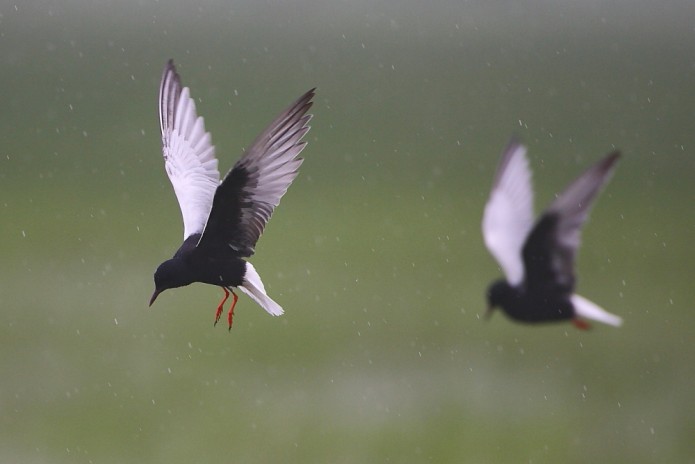
This image sums up 2010 at Nagy-Vókonya with many White-winged Terns and lots of rain... (Photo: János Oláh)
Vókonya was superb place for breeding birds and the breeding results of waterbirds in 2010 can be seen in the summary table below. The total number was higher than any of the previous 8 years due to the high number of colonial breeders such as White-winged Black Tern, Whiskered Tern and Black-headed Gull. Waders were also abundant and many Black-winged Stilts, Lapwings and Common Redshank have bred. The very high water level slowly disappeared by late autumn when the wetland was used by many thousands of geese including the endangered Red-breasted Goose. We saw a maximum of 18 of these stunning little geese roosting at Nagy-Vókonya.
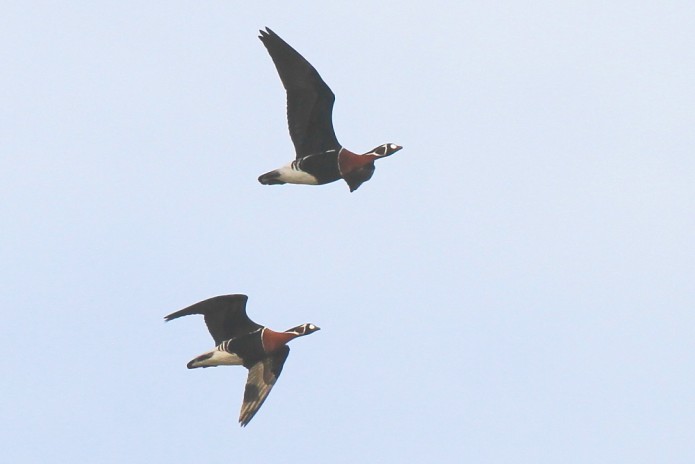
Red-breasted Geese at Nagy-Vókonya (Photo: Hugh Gallagher)
In 2010 yet again Nagy-Vókonya was the major roosting area for the migrating Common Cranes. In the table below the number of Cranes roosting at Vókonya is clearly visible and also the total number of Cranes in the Hortobágy region. With a maximum of 32 300 it was a very poor year as the usual count is around 80 000 birds. Most probably the very wet conditions made even the Cranes to move quickly through the area. We had the following contributors to the weekly Crane count: S. Harangi; J. Kecsekés; Sz. Molnár; J. Oláh; Sz. Radócz; J. Tar and T. Zalai. On behalf of HEA we say thank you for their help!
|
2010 |
09.30 |
10.07 |
10.14 |
10.21 |
10.28 |
11.04 |
11.11 |
11.18 |
11.25 |
|
Roosting Cranes at Nagy-Vókonyán |
3800 |
9500 |
10250 |
no count |
1730 |
8700 |
5800 |
5000 |
6200 |
|
Roosting Cranes in the Hortobágy |
7830 |
22550 |
32300 |
no count |
29050 |
27700 |
19800 |
16400 |
14400 |

Cranes going to roost (Photo: János Oláh)
Following the three year wetland management plan of Vókonya wetland, the year 2009 was a dry year of this area. In Spring there were plenty of remnant water bodies scattered around but these all dried up by mid Summer. The breeding results of waterbirds in 2009 can seen in the summery table below. During the Spring migration Great Snipe was recorded again a Collared Pratincole was also seen on the shrinking waters pools. On these fast disappearing water pools the Avocets attempted breeding and hundreds of Calidris waders were migrating through. In late Summer we flooded a small part of the wetland to help the grazing livestock and the migrating birds. There was superb feeding habitat for shorebirds and we recorded an astonishing four new wader soecies to the area! These were the Dotterel, the Pacific Golden Plover, Knot and Pectoral Sandpiper.

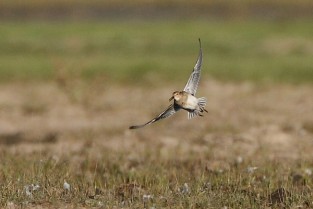
1. image: Pacific Golden Plover Pluvialis fulva, 2. image: Pectoral Sandpiper Calidris melanotos (Photos: János Oláh)
This was only the second ever record of the Pacific Golden Plover in Hungary and new bird for the bird fauna of the Hortobágy. There was also a juvenile Collared Pratincole at the wetland for several weeks and in late autumn a Black-winged Pratincole was seen for several days too. The wetland was aslo used as a roosting area for Cranes and up to 6000 individual was counted at one time. In late autumn also further observations of Red-breasted Goose and Lesser White-fronted Goose were recorded.

3. image: juvenile Collared Pratincole (Phot: János Tar)
Breeding table:
|
The total number of breeding waterbirds (pairs) at the project site between 2002 and 2009 |
||||||||
|
Year |
2002 |
2003 |
2004 |
2005 |
2006 |
2007 |
2008 |
2009 |
|
Species |
|
|
|
|
|
|
|
|
|
Podiceps nigricollis |
0 |
0 |
7 |
11 |
0 |
0 |
0 |
0 |
|
Podiceps grisegena |
0 |
0 |
0 |
0 |
0 |
0 |
3 |
0 |
|
Tachybaptus ruficollis |
0 |
0 |
6 |
9 |
0 |
22 |
26 |
0 |
|
Botaurus stellaris |
0 |
0 |
2 |
6 |
4 |
5 |
5 |
4 |
|
Ixobrychus minutus |
0 |
0 |
0 |
1 |
1 |
2 |
1 |
1 |
|
Anser anser |
0 |
0 |
0 |
2 |
6 |
5 |
9 |
7 |
|
Anas platyrhynchos |
1 |
2 |
15 |
14 |
5 |
17 |
12 |
6 |
|
Anas acuta |
0 |
0 |
1 |
0 |
0 |
0 |
0 |
0 |
|
Anas querquedula |
0 |
0 |
14 |
21 |
12 |
19 |
15 |
12 |
|
Anas clypeata |
0 |
0 |
3-4? |
4-5? |
0 |
1? |
0 |
0 |
|
Aythya ferina |
0 |
0 |
0 |
7 |
0 |
2 |
6 |
2 |
|
Aythya nyroca |
0 |
0 |
4 |
10 |
0 |
11 |
10 |
0 |
|
Rallus aquaticus |
0 |
1 |
0 |
12 |
6 |
8 |
15 |
6 |
|
Porzana porzana |
0 |
0 |
5 |
7 |
1 |
3 |
1 |
0 |
|
Porzana parva |
0 |
0 |
0 |
2 |
1 |
1 |
7 |
2 |
|
Porzana pusilla |
0 |
0 |
0 |
? |
0 |
0 |
6 |
0 |
|
Gallinula chloropus |
0 |
0 |
2 |
2 |
2 |
3 |
12 |
3 |
|
Fulica atra |
0 |
0 |
15 |
18 |
0 |
16 |
28 |
2 |
|
Recurvirostra avosetta |
0 |
0 |
36 |
16 |
0 |
0 |
0 |
6 |
|
Himantopus himantopus |
0 |
0 |
7 |
0 |
0 |
0 |
0 |
0 |
|
Charadrius dubius |
0 |
0 |
1 |
0 |
0 |
0 |
0 |
0 |
|
Vanellus vanellus |
2 |
16 |
47 |
55 |
31 |
44 |
61 |
36 |
|
Tringa totanus |
0 |
3 |
19 |
29 |
2 |
22 |
38 |
8 |
|
Limosa limosa |
0 |
0 |
11 |
10 |
0 |
19 |
25 |
6 |
|
Gallinago gallinago |
1 |
1 |
6 |
7 |
4 |
9 |
14 |
6 |
|
Larus ridibundus |
0 |
0 |
55 |
0 |
0 |
0 |
0 |
0 |
|
Sterna hirundo |
0 |
0 |
2 |
21 |
0 |
0 |
0 |
0 |
|
Chlidonias leucopterus |
0 |
0 |
6 |
210 |
0 |
0 |
0 |
0 |
|
|
|
|
|
|
|
|
|
|
|
Total |
4 |
23 |
264 |
470 |
75 |
209 |
294 |
107 |
Our English language publication presenting the revival of the Vókonya pusztas (LIFE project) titled Wetland and grassland habitat rehabilitation in the Hortobágy is to be published shortly. Since the compilation of the book, however, certain changes of the avifauna have been recorded in the region (see detailed below).
The table below shows the population changes of breeding water- and shorebirds from the outset of the project until very recently. The project was commenced in 2002, with no significant activities. In 2003 grazing was intensified; in 2004 the water at the 200 hectare wetland habitat was adjusted to a medium and in 2005 to a maximum level, while maintaining an ecologically sustainable high level of grazing. In 2006 the wetland habitat was left dry, and then it was flooded again to ensure medium (in 2007) and high (in 2008) water levels.
As a beneficial result of the high level of grazing of mixed breeds livestock, the populations of bird species most confined to such pasture meadows/lakes (Northern Lapwing, Common Redshank and Black-tailed Godwit) have not decreased during the years, but increased to see the peak number of breeding pairs in 2008.
Until the closing date of the project (30th June 2006) 225 bird species were recorded. In 2007 a further three species (Whooper Swan, Barnacle Goose and Brant Goose) enriched the area's avifauna, which then numbered a total of 228 species. In May 2007 27 individuals of Great Snipe were counted on the 200 hectare wetland habitat, and further observations of Red-breasted Goose and Lesser White-fronted Goose were recorded. In 2008 one of the greatest ornithological sensations in Hungary was that six pairs of Baillon's Crake bred in our pasture lake, and all the three Hungarian crake species successfully bred on the project site. Photos: János Oláh
